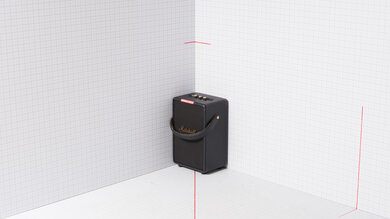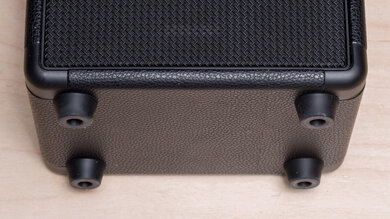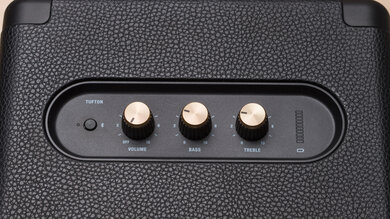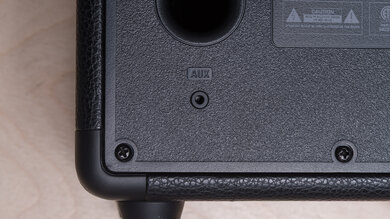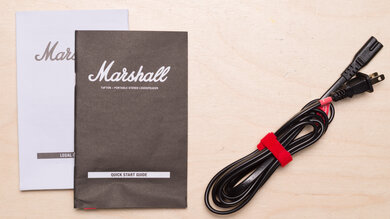The Marshall Tufton is a portable Bluetooth speaker with a distinctive retro style that makes it easy to identify as part of the brand's lineup. It features a faux-leather carrying strap which makes it easy to bring on the go, despite being on the larger size for a portable speaker. Plus, it's rated IPX2 for water resistance, so it can handle a little rain, and its long battery life means you won't have to recharge very often.
Our Verdict
The Marshall Tufton is acceptable for listening to music. It has an exaggerated V-shaped sound profile with boosted bass and treble ranges and recessed mids. Whether you enjoy this sound or not will depend on your personal taste, but you can expect a boomy sound with plenty of brightness. Conversely, vocals and lead instruments can sound distant and lack detail, while the overemphasized treble range can make sibilants sound harsh. Unfortunately, there's no graphic EQ available to tweak the sound, but you can use the bass and treble knobs on the speaker. The speaker can play in stereo and has decent directivity, so your audio will sound immersive and consistent from many angles.
-
Plays audio in stereo.
-
Bass and treble knobs available.
-
Recessed mid-range means vocals and lead instruments sound distant.
-
No graphic EQ available.
The Marshall Tufton is unremarkable for watching movies and videos. Its boosted bass range means that sound effects during fast-paced action scenes will sound exciting and realistic, but the recessed mid-range will make dialogue harder to follow and understand. The speaker gets loud enough to fill a living room with sound, but there's some compression at max volume, which results in a lack of clarity as you turn it up. With low Bluetooth latency when connected to Android or iOS devices, you won't notice lip-syncing issues when watching on a paired device. For even lower latency, you can also connect to the AUX In port on the speaker's back.
-
Low Bluetooth latency.
-
Plays audio in stereo.
-
Recessed mid-range means dialogue lacks clarity.
-
Some compression present at higher volumes.
The Marshall Tufton is okay for listening to podcasts. It gets loud enough to fill a large room with sound, but its underemphasized mid-range means that dialogue can sound a bit uneven and lack clarity. Since it doesn't have a 360-degree design, audio will change depending on the angle you listen from, but it does a satisfactory job of limiting directivity. You can also connect up to two devices via Bluetooth, so switching up audio sources is easy. Unfortunately, the speaker doesn't support multi-room pairing. Still, it has a carrying strap, so it's easy to bring from room to room or out to the backyard while you finish listening to longer episodes.
-
Carrying strap for portability.
-
Allows multi-device pairing.
-
Recessed mid-range means dialogue lacks clarity.
-
Doesn't support multi-room pairing or party mode.
This speaker doesn't support voice assistant capability.
The Marshall Tufton is satisfactory for outdoor use. It's decently built and has an IPX2 rating, which certifies it to withstand light rain but not a downpour, so it's a good idea to use caution in wet weather. With a 17.5-hour playtime on a single charge, you won't need to stay near an outlet. Plus, its carrying strap means that it's fairly easy to move around. The speaker's exaggerated V-shaped sound profile means the bass and treble will offer plenty of boom and brightness, even in open outdoor areas like a park or backyard. That said, the underemphasized mid-range can make dialogue, vocals, and lead instruments sound distant. Unfortunately, there's no in-app EQ available to adjust the sound. On the other hand, it can get plenty loud, which is ideal for outdoor listening.
-
Long battery life.
-
Carrying strap for portability.
-
Recessed mid-range means vocals and lead instruments sound distant.
-
No graphic EQ available.
- 6.4 Music
- 6.1 Videos/Movies
- 6.6 Podcasts
- 2.5 Voice Assistant
- 7.3 Outdoors
Changelog
- Updated Mar 26, 2025: Review published.
- Updated Mar 19, 2025: Early access published.
- Updated Mar 18, 2025: Our testers have started testing this product.
- Updated Mar 12, 2025: The product has arrived in our lab, and our testers will start evaluating it soon.
- Updated Feb 27, 2025: We've purchased the product and are waiting for it to arrive in our lab.
Check Price
Differences Between Sizes And Variants
The Marshall Tufton speaker is available in 'Black' or 'Black and Brass.' We tested the 'Black and Brass' model and expect other variants to perform similarly. See the label for our unit.
If you encounter another variant, please let us know in the comments, and we'll update our review.
Compared To Other Speakers
The Marshall Tufton is a portable Bluetooth speaker with a design inspired by music industry gear, similar to other offerings from the manufacturer. Aesthetically, it resembles stylish retro speakers like the JBL Authentics 200 or Klipsch The Three II, though it lacks the JBL's voice assistant and app support. It's larger and heavier than other portable options from the same brand, like the Marshall Willen and Marshall Emberton II. Its size makes it more of a challenge to bring with you on the go, but means it can get louder than these more compact options, too.
If you want more speakers to explore, see our recommendations for the best Bluetooth speakers, the best portable Bluetooth speakers, and the best Bluetooth speakers for bass.
The Marshall Tufton and Marshall Woburn III have different use cases, so your choice will depend on how you plan to use it. The Woburn III is designed as a home speaker. It can connect to your TV through its HDMI ARC input. It has great controls and access to a companion app, unlike the Tufton. It also gets louder, with less compression, so your audio sounds clear at loud volumes. The Tufton, conversely, is a portable Bluetooth speaker meant to be used at home and outside. It's battery-powered, unlike the Woburn III, and has protection from light rain with an IPX2 rating.
The JBL Boombox 3 is a better speaker than the Marshall Tufton for most people. The JBL has a much more balanced sound, which is suitable for a variety of genres. It also offers a graphic EQ through the companion app, so you can adjust the sound to your liking. While the Marshall is smaller and thus slightly easier to carry, the JBL is rated IP67, certifying it to be dust-tight and submersible, while the Marshall can only handle light rain. The JBL also has a longer battery life, although it takes longer to charge, too. On the other hand, the Marshall can get louder, albeit with some loss of clarity as you turn it up.
The Marshall Middleton is the better choice for most users compared to the Marshall Tufton. The Middleton has a more balanced sound, making it a good choice for various music genres and audio content while the Tufton has a bass-heavy sound some users may also prefer. When it comes to soundstage performance, the Middleton has the edge—it sounds more consistent from various listening angles. It's also rated IP67 for water and dust resistance, which means it can handle a trip to the beach or a fall into the pool. The Tufton is rated IPX2, so it can only manage a little rain. That said, the Tufton has a much longer battery life, and it gets louder than the Middleton.
The Bose SoundLink Flex (2nd Gen) is a more versatile speaker than the Marshall Tufton. The Bose has a more balanced sound profile, making it suitable for various audio types and genres. It also has both voice assistant and app support with a graphic EQ and presets. Combined with a wider array of physical controls, the Bose is more convenient and customizable. The Marshall, however, has a much longer battery life, and it can get louder, though with some compression that affects the clarity of your audio as you turn it up. While the Marshall is pretty easy to carry with one hand, the Bose is small enough to toss into your backpack.
Test Results
Like other offerings from the brand, the Marshall Tufton speaker has a stylish retro design. This speaker, in particular, is modeled after music industry gear with an amp-like body and guitar strap-inspired handle. It has a tall frame with a metal mesh grille covering the drivers, and it's finished in leather-textured plastic, which mimics the Tolex covering on many guitar amps. You can find it in either 'Black' or 'Black and Brass,' like our unit, which has brass controls and accents.
Although this speaker is larger and heavier than many portable Bluetooth options, its detachable strap makes it easy to carry with one hand. For context, it's about half the size of the Marshall Woburn III, a wired-only home speaker meant mainly for stationary use. It's also battery-powered, so you won't have to worry about finding an outlet to use it.
This speaker has a decent build quality. Its body, which is primarily made of plastic, sits on four rubber feet. While it's not rated for impact resistance, hard plastic corner guards help protect it against bumps. That said, the mesh metal grille in front has some give where the drivers are located, so avoid impacts to this area. The rear panel is securely attached with screws and features a bass port as well as a vent for the rear speaker. An IPX2 rating for water resistance means it can handle light rain, and a rubber flap covering the AC input adds additional protection against the elements. However, this speaker isn't meant to join you poolside, and it's not the best choice for a day at the beach. If you're looking for something dust-tight and submersible, check out the Marshall Middleton.
The Marshall Tufton doesn't have very many controls. You'll find three large, clearly labeled knobs on top of the speaker that control the volume, bass, and treble levels. They have indents along the sides to make them easy to turn, but they're still a bit stiff. Next to these, there's an embossed Bluetooth button and an LED to indicate power settings. You can press the Bluetooth button to wake the speaker from sleep mode, hold it for two seconds to enter pairing mode, or hold it for seven seconds to perform a factory reset. On the other side of the knobs, there's an LED bar to indicate the battery level. Unfortunately, there are no controls for audio playback on the speaker, so you'll have to use your connected device to manage this. You'll hear audio feedback when the speaker connects or disconnects from Bluetooth or when you plug it into a power source. There's no chime when you reach minimum or maximum volume.
The Marshall Tufton's frequency response accuracy is not bad. It uses a subwoofer, two full-range drivers (one of which is facing the back of the speaker), and a tweeter. With the bass and treble knobs both set to five (out of 10), it has an extreme V-shaped sound profile with elevated bass and treble ranges and recessed mids. The boost throughout the bass range results in a deep, boomy sound, while the heightened treble adds plenty of brightness but can also verge on harsh and piercing. Meanwhile, the recessed mid-range means that vocals and lead instruments can sound distant and lack clarity.
The speaker displays a V-shaped sound profile even when the bass and treble knobs are set to their minimum values. Unfortunately, there's no additional EQ available to tweak the sound further. At maximum volume, this response flattens out a bit, though. You may also notice a slight change in frequency response depending on which input you use.
There are three amps in total: one for the subwoofer, one for the mid-range drivers, and one for the tweeter. The manufacturer states that when the volume, bass, and treble knobs are all set to a high level, audio clipping can occur. We didn't experience this in our testing, but it's something to keep in mind.
The Marshall Tufton has a very good soundstage. It can play stereo content without downmixing to mono, so you'll notice some separation between the left and right channels. That said, the drivers are very close together, so the effect is relatively subtle. While it doesn't have a 360-degree design, the rear-facing speaker does a decent job of minimizing directivity; however, you'll still notice some changes in the way audio sounds as you move around the speaker.
This speaker's dynamics performance is alright. It gets loud enough to fill a large room or outdoor space with sound, but there's some compression present as you turn up the volume, which affects the clarity of its output. We also found that the bass and treble knobs affected the volume level; as you turn them up, the maximum volume increases slightly.
This speaker has a fantastic battery performance. Its battery life is advertised to last approximately 20 hours at medium volume, and in our standardized tests, it lasted 17.5 hours. We were able to fully charge it in just over two hours, and the manufacturer also says you can get four hours of playtime with a 20-minute charge, which is handy when you're in a hurry. There's also a power-saving feature: the speaker will enter sleep mode after 10 minutes of inactivity. You can wake it by pressing the Bluetooth button.
You can connect a device and play audio through the 3.5mm (1/8") AUX connection on the speaker's back. We found that this connection offers very low latency, so you won't notice any lag.
This speaker has outstanding Bluetooth connectivity. You can pair up to two devices, so it's easy to switch between audio sources, and its long range means you can move around freely without worrying about disconnecting. It also has low latency with both Android and iOS devices, so you can watch videos on a paired device without noticeable lip sync issues. However, various apps and devices compensate differently for latency, so your experience may vary.
Comments
Marshall Tufton: Main Discussion
Let us know why you want us to review the product here, or encourage others to vote for this product.
The full review has been posted here. Let us know what you think!
- 32120
I am very interested in tufton review. At the same time, I wonder why Marshall didn’t make a newer version of Tufton, because some portable speakers have a second version, and cable speakers even have a third version.



